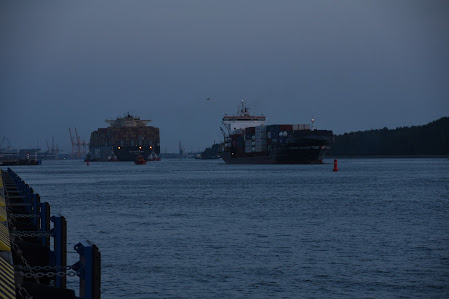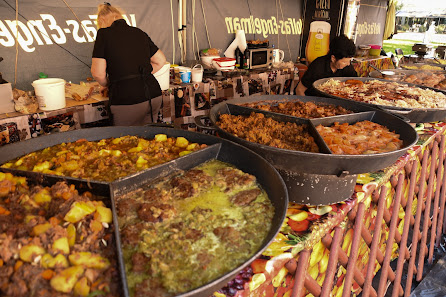Lithuania is the only country on our travels this trip, before Sweden, that was independent before the end of WWI. And my goodness, it was a significant country. In my blog about Poland I mentioned that in the seventeenth century the Polish/Lithuanian commonwealth was the largest and wealthiest country in Europe. It was an alliance to defend against the growing power of their neighbors Russia and Sweden. But before that Lithuanian on its own was the largest and wealthiest country in Europe. It spanned from the Baltic Sea to the Black Sea; from current borders to the gates of Moscow, parts of Poland, western Ukraine including Kiev, and all Belarus and Slovakia.

Lithuania at its maximum territorial size
On leaving Liepeja, Latvia we again faced inland to cross the boarder and visit Zemaitijos National Park. The centerpiece of this Park is a lake. By comparisons to our National Parks, most of those in the "Baltics" might qualify as a State Park, and not much more. But these countries are tiny compared to the US and they are quite proud of their natural environment, so we wanted to visit as many as we could.
Shore walk along Zemaitijos N.P.
After an afternoon walk along the lake we headed back to the coast and the city of Klaipedia at the entrance to the Couronian Spit. As previously mentioned, Couronian Spit is named after an indigenous tribe of the Baltic. It's a thin barrier of sand about 60 miles long and less than 1/2 mile wide shared by Lithuania and the Russian Territory of Kaliningrad, formerly Konigsberg under Germany. It's about the twice the length of Fire Island off Long Island, NY and a quarter the Outer Banks off North Carolina. All are about the same width.
Curonian Spit split between Russia and Lithuania
Klaipeda waterfront restaurants along entrance from the Baltic to Curonian Lagoon
Shipping to and from Russia through Curonian Lagoon
From Klaipeda we drove to the boarder of Russia Kaliningrad and the resort town of Nida. It was pretty quiet this time of year, but charming. One could see that in warmer months it would be quite delightful. Sandy beaches, charming cottages, and dune walks.
Waterfront walk along Nida.
Trail through coastal forests to the sand dunes
Overlooking sand dunes and trails which are constantly modified by the winds.
French author and philosopher Jean Paul Sartre
was a frequent visitor as the area is conducive to contemplation.
Tombstones above a village complete swallowed up by shifting sands.
Photo of photo of traditional festival every year.
After our two night stay on the spit, we headed back toward Klaipeda and inland toward Vilnius to stay in the former capital Kaunas, the second largest city in Lithuania. This was supposed to be just an overnight stay to break up the drive, but the city turned out to be quite charming with a lot of history as the capital and center of resistance to multiple occupations.
The main pedestrian promenade becomes a street fair once a year - while we were there.
Street food for the fair.
Christ's Resurrection Church build during the interwar period when Kaunas was the Capital.
In the Book Smugglers Yard (plaza) commemorating Lithuania's attempt to maintain their written language during Russia's occupation and ban on the local language there is a statue of the Sower of Seeds installed in the thirties. A local graffiti artist added stars to the wall behind which makes no sense during the day. However, at night with the statue illuminated he becomes "The Sower of Stars". Pretty cool. The City painted over the stars as vandalism, but by popular demand they returned and are now celebrated.
Local maintenance worker with Sower of Seeds in daylight...
becomes the sower of stars at night.
A small courtyard surrounded by apartments which was transformed by
mural artist into a community similar to Christiana is Copenhagen
Many portraits of residents adorn the walls. This of a former Jewish resident.
From Kaunas we drove to Vilnius, returned the car at the airport with no human interaction (all on-line), and checked into our small hotel near one of the city plazas. If Tallinn was about a preserved medieval core and hi-tech economy, and Riga the regional capital city and historic center and for it's Art Nouveau buildings, Vilnius is a young person's city with plazas, entertainment, and restaurants. We advised Teigan when we met her in Stockholm that for a short flight from London she and her friends ought to spend a weekend in Vilnius. It's just a fun city. It also has great history, and jewish ghetto for us older buffs to appreciate.
Dinner along happening street scene.
Restaurants were fully booked, we just were lucky someone canceled.
Interior of Baroque Catholic Church
Exterior of Orthodox Church
Flower petals instead of rice at festive local Wedding.
Our hotel on left within historic jewish ghetto.
Teutonic knights at Parliament.
I collect photographs of strangers that are curious, and
often of the absurdity of modern dating or vanity selfies.
Girl grooving, with selfie video, in her freeform reverie.
Medieval Gediminas Castle of the 15th century.
Grand Duke Gediminas is credited with founding the Lithuanian Capital.
Below the castle on the riverbank is the cultural center of Vilnius.
Historic center of the Jewish Quarter.

Similar street during Jewish Pograms.
Commemorative plaques and information boards about the former ghetto and its inhabitants.
Throughout the ghetto are illustrations from actual photographs from the WWII period.
Bust of 18th century rabbi (meaning teacher) Vilan Gaon of Vilnius, who slept no more than two hours a night
and would often work with his feet in a bowl of cold water in unheated space to avoid dozing.
Gaon, meaning Genius, was taught by his rabbi father and gave his first lecture on the Talmud at seven years old.
Leonard Cohen is the famous son of Lithuania and Vilnius
Our final lunch at our favorite side street restaurant in the former ghetto.


































